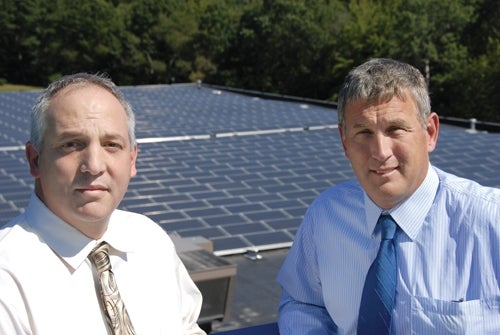When Wilson Language Training moved to new corporate headquarters in Oxford, company officials put air conditioning in the new offices and teacher training area.
But they did not install air conditioning in the 20,000-square-foot material distribution center — a move that proved short-lived because of the impact on employees and products.
“Because we handle paper products, books and educational supplies, and the busiest season is the summer, it’s important for us to cool it to working temperature for the people and the paper,” said Edward Wilson, co-owner and CFO for Wilson Language Training.
Wilson Language Training publishes the Wilson Reading System, developed by Barbara Wilson, company president and Wilson’s wife.
The 90-employee company relocated its corporate headquarters from small mill space in Millbury to the new Oxford complex set on 10 acres in 2004.The site features 26,000 square feet of office and teacher training space and the attached material distribution center.
In addition to hurting employee morale and product quality, Wilson said the company was adding to its costs by forgoing air conditioning.
“If it gets too humid, (your product) just gets heavier and your shipping cost just goes up,” he said. “It absorbs water.”
Solving the problem of how to pay for air conditioning has propelled Wilson Language Training into an unexpected spotlight for something beyond Barbara Wilson’s renowned reading instruction. When installed, its rooftop solar panel system was the largest to receive funding from the state’s Commonwealth Solar rebate program.
Return On Investment
Company officials pursued solar panels after considering a wide range of alternative energy sources, including geothermal energy and wind. Their goal was to cover as much of the material distribution center’s roof as possible to maximize energy savings.
Wilson Language Training contracted with Borrego Solar to manage installation of Sanyo solar panels. It installed the air conditioning units in April 2008 and installation of 714 solar panels began a month later, according to Bert Baldarelli, senior director of financial services for Wilson Language Training. Work lasted approximately three months and the solar panels began producing electricity in December 2008.
The 140-kilowatt solar panels cost $1.2 million, but Wilson Language Training received a $420,000 rebate from the Commonwealth Solar rebate program, which the state launched in 2008 to encourage solar panel installations. The company also took advantage of federal tax incentives, Baldarelli said.
The solar panels will save the company 20 percent annually on utility bills and pay for itself in less than six years — though Wilson Language Training expects to get decades of use.
“This solar system will be up there producing energy for 30-plus years,” said Jared Connell, an energy consultant with Lowell-based Borrego Solar who worked on the project.
Baldarelli recommends other companies pursue the tax credit program. He said his July 2009 electric bill was down $10,300 from July 2008, before the solar panels went live.
“Ten thousand dollars a month, that’s a significant dollar value when you talk about the economy we’re living in now, when you’re working in an industry where we’re trying to provide value,” Baldarelli said.
He said it’s also nice to receive a check from National Grid for surplus energy the solar panels allow his company to sell the utility.
“I get to bill National Grid and I’ll tell you, that’s really cool,” Baldarelli said.
His one regret is Wilson Language Training didn’t include more steel when it built its material distribution center roof. Adding $10,000 more in steel, he said, would have allowed the company to fit up to 850 solar panels on the roof.
But knowing what he knows now, he said he would probably advocate for just incorporating solar panels into the original construction — something Connell said he’s only seeing on about 5 percent of his solar installation projects at Borrego Solar.
At 140 kilowatts, Wilson Language Training’s solar panel system is among the largest rooftop installations in the state — but it doesn’t take the title.
The largest is a 411-kilowatt system atop Majilite Corporate in Dracut, followed by a 377-kilowatt system on the roof of the General Services Administration building in Waltham, according to Lisa Capone, press secretary for the Massachusetts Executive Office of Energy and Environmental Affairs. Harvard University has also proposed a 500-kilowatt system in Watertown.
The state currently has 1,215 residential solar systems providing about 5.2 megawatts of energy and 316 non-residential solar systems generating 7.3 megawatts of energy, Capone said.
In Oxford, Wilson Language Training’s solar panel system now has it thinking green in other ways. They also installed energy efficient lighting in the material distribution center last year and are actively pursuing other rebate programs. The company also owns more land in Oxford that hasn’t been designated for use, Wilson said.
“Our vision is any development we do will be green, sustainable,” he said. n
Sara Withee is a freelance writer based in Millis. She can be reached at sara.withee@nescopywriting.com.

